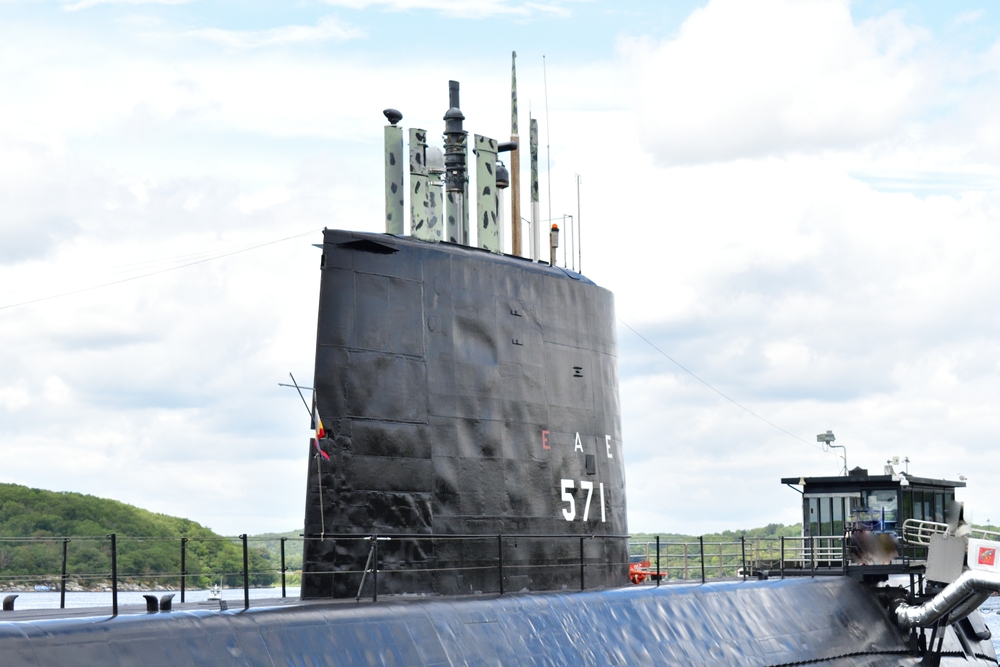General Dynamics Electric Boat Shipyard, in Groton, Connecticut, is respected for fabricating submarines, including the world’s first nuclear submarine. But throughout its history, the shipyard’s personnel risked asbestos exposure. Many of these workers were diagnosed with malignant mesothelioma, asbestosis, and other asbestos-related conditions, while others are still at risk for these serious illnesses.

Why Was Asbestos Used in Ship and Submarine Building?
Asbestos was a common component of all types of maritime construction during the early twentieth century, when its superior fire resistance and insulating qualities, as well as its low cost and easy accessibility, made it a natural choice.
The U.S. Navy mandated asbestos use in submarines by 1922, especially in parts including gaskets, insulation, packing, and tape. By 1939, the United States government had designated asbestos as strategically vital and initiated stockpiling efforts.
From that time until the 1970s, when research conclusively identified it as being carcinogenic, the material was widely utilized to strengthen and insulate virtually all types of shipboard components.[1]
The History of General Dynamics Electric Boat Shipyard
Established in 1899 by John P. Holland and Isaac Rice to complete the submersible designs developed by John Philip Holland, Electric Boat quickly established itself as the premier submarine manufacturer for the United States Navy.
The shipyard produced the Navy’s first commissioned submarine, the Holland VI, later renamed the USS Holland, SS-1, in 1900. The vessel was the first submarine purchased and commissioned into the United States naval service, and established the foundation for a long relationship with the military.[2]
The success of the Holland VI led to many more submarines being ordered and built. Foreign governments, including Great Britain, Japan, Russia, and the Netherlands, purchased the rights to build the vessels under licensing contracts with the company in compliance with the Hague Conventions of 1899 and 1907. During World War I, Germany made use of the vessels in unrestricted ways.[2]
Throughout its history, Electric Boat demonstrated remarkable productivity during major conflicts. The facility constructed 85 submarines during World War I and 74 submarines during World War II.
It renamed itself General Dynamics Corporation in 1952, though as the company expanded, it later used the Electric Boat name for its submarine building corporation.
A few years later, in 1954, the company created its most significant technological advancement: The world’s first nuclear submarine, the USS Nautilus. This was followed in 1959 by the construction of the George Washington, the world’s first ballistic nuclear submarine.[2]
The Cold War years represented the company’s most active time, with Electric Boat’s staffing growing to approximately 25,000 workers by the 1980s.
The Groton shipyard expanded to 118 acres and was eventually responsible for producing nearly all of the U.S. Navy’s Los Angeles, Virginia, Seawolf, and Ohio class submarines. Among the notable vessels produced at the facility are the USS Cuttlefish, USS Triton, USS Sturgeon, USS Philadelphia, USS Ohio, and USS Lafayette.[2]
Though most of the work performed by Electric Boat focused on building new submarines, the shipyard also provided repair and overhaul work for fast attack-class boats. In 2002, it conducted preservation work on the USS Nautilus in preparation for being displayed at the U.S. Navy Submarine Force Museum and Library.
The submarines built or repaired by Electric Boat Corporation include:
- USS ALEXANDER HAMILTON
- USS TAMBOR (SS-198)
- USS BARRACUDA (SSK-1)
- USS S-32 (SS-137)
- USS CUTTLEFISH (SS-171)
- USS TARPON (SS-175)
- USS PERMIT (SS-178)
- USS SALMON (SS-182)
- USS SEAL (SS-183)
- USS SKIPJACK (SS-184)
- USS SARGO (SS-188)
- USS SAURY (SS-189)
- USS SPEARFISH (SS-190)
- USS SEADRAGON (SS-194)
- USS TAUTOG (SS-199)
- USS THRESHER (SS-200)
- USS MACKEREL (SS-204)
- USS GAR (SS-206)
- USS GRAYBACK (SS-208)
- USS GATO (SS-212)
- USS GREENLING (SS-213)
- USS GROUPER (SS-214)
- USS GROWLER (SS-215)
- USS GRUNION (SS-216)
- USS GUARDFISH (SS-217)
- USS BARB (SS-220)
- USS BLACKFISH (SS-221)
- USS BLUEFISH (SS-222)
- USS COD (SS-224)
- USS CERO (SS-225)
- USS ANGLER (SS-240)
- USS BASHAW (SS-241)
- USS BLUEGILL (SS-242)
- USS BREAM (SS-243)
- USS CAVALLA (SS-244)
- USS COBIA (SS-245)
- USS CROAKER (SS-246)
- USS DACE (SS-247)
- USS FLASHER (SS-249)
- USS FLOUNDER (SS-251)
- USS GABILAN (SS-252)
- USS GUNNEL (SS-253)
- USS GURNARD (SS-254)
- USS HADDO (SS-255)
- USS HAKE (SS-256)
- USS HOE (SS-258)
- USS JACK (SS-259)
- USS LAPON (SS-260)
- USS MINGO (SS-261)
- USS MUSKALLUNGE (SS-262)
- USS PADDLE (SS-263)
- USS PARGO (SS-264)
How Did General Dynamics Electric Boat Use Asbestos?
Electric Boat began building submarines long before asbestos had been linked to serious health conditions. Since the U.S. Navy began specifying the use of the mineral in 1922, there was no question about its use.
The company continued to use asbestos until its dangers became public knowledge and the Clean Air Act of 1970 granted the Environmental Protection Agency authority to regulate the mineral’s use and disposal.
During the years that the company’s submarine production was most active, the Navy considered asbestos invaluable. Asbestos was important for its characteristic heat and flame resistance, and this was especially true for submarines, where a fire would be devastating.
The mineral’s characteristic light weight and flexibility also made it even more useful for the compact spaces inherent in the underwater vessels.
Electric Boat used asbestos in many components of its submarines, including:
- Boilers, turbines, pumps, and valves
- Pipe insulation
- Condensers, evaporators, and distillation equipment
- Accumulators
- Exhaust duct systems
- Refrigerant/refrigerated store spaces
- Submarine hull insulation
- Firefighting gear
- Gunner’s protective gear
- Gaskets
- Spray-on hull insulation
- Thermal and acoustic insulation for ducts
- Doors and hatches
- Electrical components
- Adhesives
- Flooring
- Wall materials
Who Was at Risk of Asbestos Exposure from Electric Boat Asbestos?
Electric Boat’s workers were at risk of asbestos exposure from both the materials that were used in building the company’s submarines and the various parts and equipment components used in maintenance and repair.
It’s been estimated that every naval submarine the company constructed contained approximately 60,000 pounds of asbestos thermal insulation, and its nuclear submarines’ extensive high-temperature steam systems required even more asbestos-containing materials.
The greatest danger to the company’s employees came while it was using asbestos-containing materials in submarine construction. Health risks continued for years after the material’s dangers had been recognized and safety regulations put in place.
Submarine engineers and maintenance crews were then assigned to remove the dangerous material from existing equipment, often without appropriate protective equipment and working in confined spaces with poor ventilation.
Secondary Exposure
Beyond the direct workplace hazards, there was also a risk to the family members of the shipyard’s workers. When asbestos fibers that the employees disturbed came to rest on their work clothes, skin, or hair, they unknowingly carried them into their homes.
This indirect route is known as secondary exposure, and many spouses and family members of individuals with occupational asbestos exposure developed serious asbestos-related conditions, particularly those who spent years laundering contaminated work clothes.
Navy Veterans
In addition to the occupational exposure experienced by Electric Boat’s employees, Navy crew members who served onboard the vessels were also exposed to asbestos in varying degrees based on their job assignments.
While enginemen and machinists who frequently worked around asbestos-insulated boilers and turbines faced particularly high exposure levels, the physical environment within the vessels meant that once asbestos was disturbed, it floated freely through the submarine’s constantly recirculating ventilation system.
Research Confirms Risk of Asbestos Exposure for Electric Boat Employees
There is significant documentation of workers’ exposure to asbestos at Electric Boat’s shipyard, and of the particular dangers posed to workers with eight or more years of experience in the environment, especially those involved in submarine overhaul and retrofitting operations.
In an investigation that was controversial at the time, renowned asbestos researcher Dr. Irving J. Selikoff examined 1,000 of Electric Boat’s Groton-based employees. He found that approximately half of the Electric Boat workers had abnormalities consistent with asbestos exposure on X-rays.
“The abnormalities were found not only in insulators who used asbestos, but in all production trades,” Selikoff noted. “Asbestos was a ubiquitous contaminant in the yard, with many workmen exposed.”
After his 1975 to 1979 study, he conducted a mortality study of 1,918 long-term Electric Boat workers across various trades, including pipefitters, boilermakers, painters, carpenters, electricians, machinists, laborers, and foundry workers. He found elevated mortality rates from all causes, but especially of cancers affecting the lung and gastrointestinal tract, as well as respiratory diseases.[3]
Lawsuits Involving General Dynamics Electric Boat
Because the work conducted by General Dynamics Electric Boat was performed under the control and direction of the U.S. military, personal injury lawsuits filed against the company have been largely unsuccessful.
The same is not true for the asbestos companies that provided Electric Boat with the asbestos-containing materials that they used. Most of these companies were aware of the dangers of asbestos but chose to keep the information quiet.
As a result of this negligent behavior, many victims of mesothelioma and other asbestos-related diseases have found justice by pursuing legal claims against these companies. Some examples include:
- In 1989, Cecilia Champagne, a widow, filed a wrongful death lawsuit against Raybestos-Manhattan on behalf of her late husband, Wilfred, as administratrix of his estate. Mr. Champagne had worked at Electric Boat as a pipe coverer from 1959 to 1979. He had been responsible for insulating various systems during the construction and overhaul of submarines and had handled several products containing asbestos. Raybestos-Manhattan, Inc. had supplied asbestos cloth to the company for this purpose between 1959 and 1973, as did Eastern Refractory Company, Cummings Insulation, and others. Her claim against the companies was successful.[4]
- In 1982, the first of more than 300 suits brought by employees and former employees of the Electric Boat plant was heard in federal court. The case was filed by Mr. Joseph LaBrecque, who had worked as a metal burner at the plant for 33 years. He and others asserted that their health had been harmed by asbestos insulation used in the plant’s manufacturing operations. The total compensation being sought by all of the claimants was more than $180 million. This action followed fifty other suits having settled out of court for more than $6 million in 1980 and 1981.[5]
While Electric Boat was shielded from liability for asbestos personal injury claims, the company did establish a “no-fault compensation fund for its employees with claims of occupational disability due to asbestos exposure.[5]
Were You Exposed to Asbestos at General Dynamics Electric Boat?
Know the Warning Signs
Occupational asbestos exposure, like that suffered by employees of Electric Boat, can cause malignant mesothelioma, asbestosis, lung cancer, and various other asbestos-related diseases.
If you worked on submarines or other vessels at Electric Boat or served on one of their submarines, you may be at risk. Even if you currently have no symptoms and feel well, understanding the dangers associated with past asbestos exposure remains crucial, as does knowing the warning signs.
Asbestos illnesses have long latency periods, and it often takes between 20 and 50 years for symptoms to appear. Because the first signs of mesothelioma frequently resemble less serious illnesses, both patients and their doctors tend to miss the correct diagnosis.
Making sure that your physician knows your occupational history can go a long way toward avoiding a missed or delayed diagnosis and provide you with more treatment options.
Help for Those Who’ve Been Diagnosed With Mesothelioma
If you or someone close to you has received a mesothelioma diagnosis after having worked at Electric Boat or on one of the submarines they built, you may be eligible for compensation.
Your options include filing a personal injury lawsuit against the companies that supplied asbestos to the shipyard or filing claims against asbestos trust funds established by any of those manufacturers that have filed for bankruptcy and been required to provide compensation for victims as part of their reorganization.
Companies that provided asbestos-containing products to Electric Boat included Atwood & Morrill (now part of Trillium Flow Technologies), Elliott Turbomachinery Co., Babcock & Wilcox, Combustion Engineering, Fibreboard, G-I Holdings (GAF), Keene Corporation, Owens Corning, and Pittsburgh Corning.
The best way for you to explore your options and get the answers you need is by reaching out to an experienced mesothelioma attorney who specializes in helping those injured by exposure to asbestos. These knowledgeable professionals have extensive resources to help you identify those responsible for your exposure and make sure you get the compensation and justice you deserve.
References
- NIH, National Library of Medicine. (September 2008.). Asbestos and Shipbuilding: Fatal Consequences.
Retrieved from: https://pmc.ncbi.nlm.nih.gov/articles/PMC2604477/ - Electric Vehicle News. (N.D.). General Dynamics Electric Boat.
Retrieved from: https://electricvehiclesnews.com/Boats/General_Dynamics_Electric_Boat.htm#:~:text=Point%2C%20Rhode%20Island.-,History,Elizabeth%2C%20New%20Jersey%2C%20USA. - Scribd. (January 27, 1984.) Selikoff & Nicholson, Electric Boat Groton Connecticut Cohort 1984
Retrieved from: https://www.scribd.com/document/145900049/Selikoff-Nicholson-Electric-Boat-Groton-Connecticut-Cohort-1984 - Casemine. (August 8, 1989.) Champagne v. Raybestos-Manhattan, Inc.
Retrieved from: https://www.casemine.com/judgement/us/5914c098add7b049347b4b68 - New York Times. (January 19, 1982.) Worker’s Suit Over Asbestos at Groton Shipyard to Open.
Retrieved from: https://timesmachine.nytimes.com/timesmachine/1982/01/19/177639.html?pageNumber=40

Terri Heimann Oppenheimer
WriterTerri Oppenheimer has been writing about mesothelioma and asbestos topics for over ten years. She has a degree in English from the College of William and Mary. Terri’s experience as the head writer of our Mesothelioma.net news blog gives her a wealth of knowledge which she brings to all Mesothelioma.net articles she authors.

Dave Foster
Page EditorDave has been a mesothelioma Patient Advocate for over 10 years. He consistently attends all major national and international mesothelioma meetings. In doing so, he is able to stay on top of the latest treatments, clinical trials, and research results. He also personally meets with mesothelioma patients and their families and connects them with the best medical specialists and legal representatives available.


